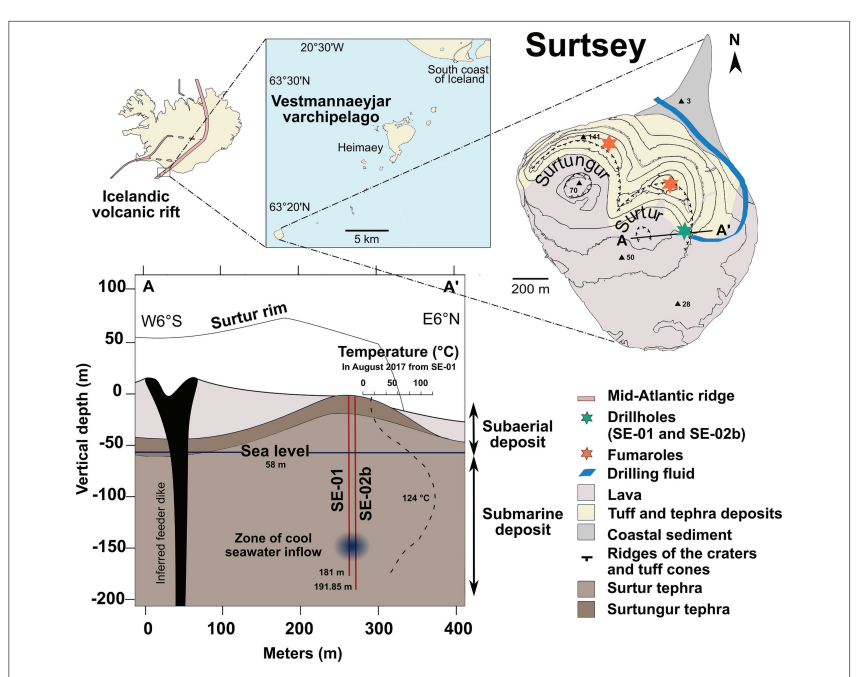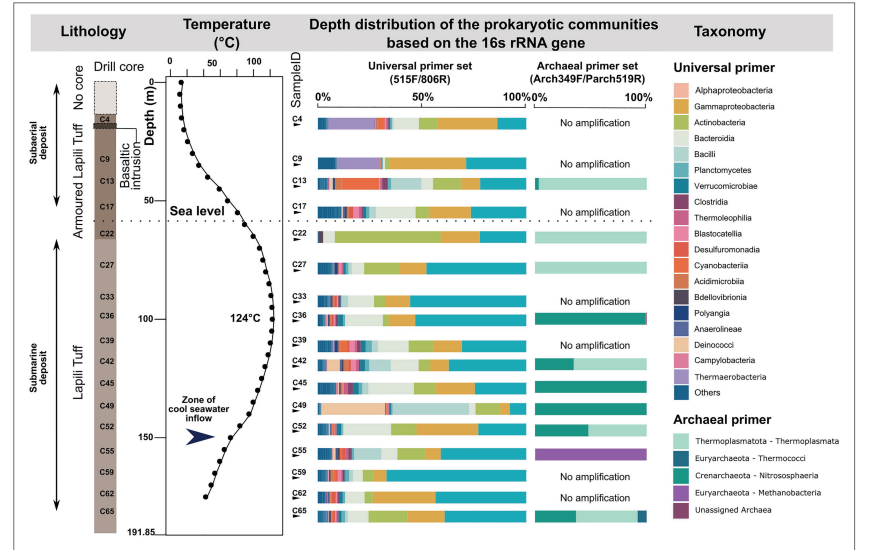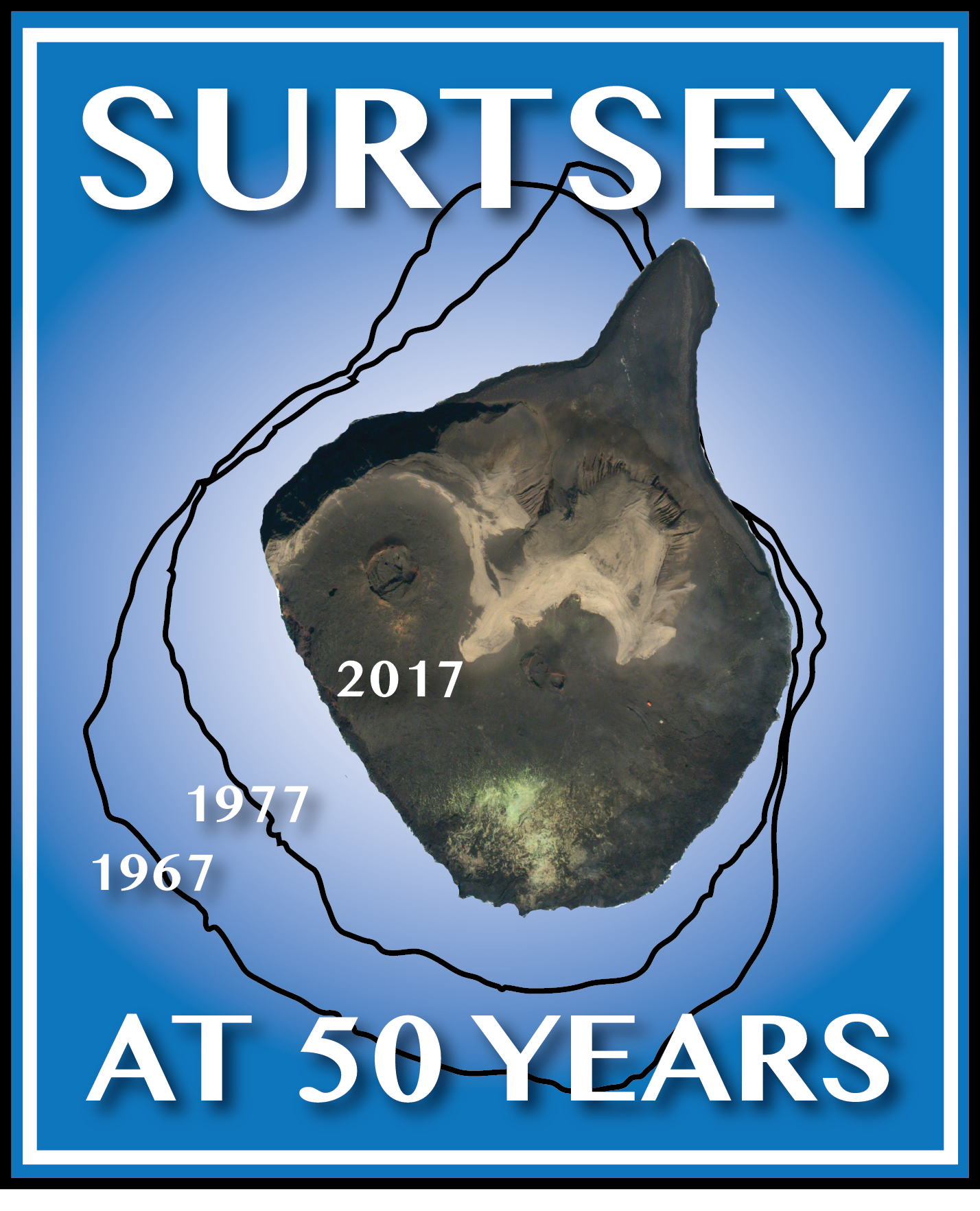The SUSTAIN drilling project offers a unique opportunity for the study of microbial communities within the basalt of a very young oceanic island, 50 years after the eruptions terminated. Pauline Bergsten and other scientists examined the diversity, distribution, and abundance of microorganisms in subaerial and submarine pyroclastic rocks and fluids from Surtsey. Using 16S rRNA gene amplicon sequencing and scanning electron microscopy analyses, they found diverse and distinct microbial communities throughout the diverse environments sampled. (Read more about the borehole fluid samples here)
The 41 samples studied fell into one of four categories: basalt from the drill core from the 2017 SE-02b borehole, fluids from the 1979 SE-01 borehole, steam from surface cracks of fumaroles, and seawater samples collected off the northwest coast of Surtsey. Seventeen drill core samples were collected for microbial analyses. Eighteen fluid samples were collected in 2016 and 2017, using a custom-built sampler, made from stainless steel. Steam samples were collected from two fumaroles: Surtur, the eastern tephra cone, and Surtlungur, the western tephra cone. Overall, 5,350 ml of steam was continuously collected over 12 hours in 2017 through the use a sterile rubber hose, one end of which was placed in the outlet of the fumarole and the other connected to a sterile plastic container where the steam accumulated. 4 L of seawater was collected 25 km offshore and was filtered through 0.22 μm Sterivex™ filters immediately after collection.

Remarkably, the study shows that diverse microbial communities, consisting of bacterial and archaeal clades, have developed on Surtsey over its short 50 years of existence. The drill cores of basalt and the fumaroles, borehole fluids and seawater host significantly different microbial communities, yet some of the same taxa can be found in multiple samples. This suggests the possible transfer of microbes across habitats.
A diverse array of taxa was found in the SE-01 borehole fluid samples, several of which have been previously found living in environments such as hot springs, hydrothermal vents. The presence of specific taxa, Halomonas and Aliivibrio, in the fluid of the SE-01 borehole before the 2017 renewed drilling, demonstrates how the infiltration of seawater into the basaltic deposits can transport marine microorganisms into the subsurface and hydrothermal environments. The presence of other taxa, including Desulfatiglans and Sulfurospirillum, indicate that the submarine deposits may have an active sulfur cycle, since these taxa can be involved in sulfur reduction and oxidation. This hypothesis is reinforced by the presence of Thermococcus, which is often involved in sulfur cycling, along with the crystallization of sulfate minerals, such as anhydrite, in the basalt.

In total the bacterial microorganisms from the drill core samples include 35 phyla, with ten (Proteobacteria, Bacteroidota, Actinobacteriota, Firmicutes, Cyanobacteria, Deinococcota, Planctomycetota, Verrucomicrobiota, Acidobacteriota, and Chloroflexi) comprising over 95% of those present. Since the basalt drill core comes from subaerial and submarine deposits, the distribution of microorganisms across these samples is an important reference point. The presence of taxa such as Marinobacter, which is commonly found in marine basaltic habitats, in the subaerial deposits suggests that the Surtsey microbial communities have adapted to withstand more extreme conditions including high temperature (up to 100 °C) and high salt concentration. The ability of microorganisms to adapt to new environments and expand across ecosystems has apparently driven the colonization of the young basalt.
Within 10 drill core samples, Archaeal microorganisms were detected and categorized into six identifiable phyla Crenarchaeota (mainly Nitrososphaeria), Thermoplasmatota (mainly Thermoplasmata), Euryarchaeota, Halobacterota, Hydrothermarchaeota, and Nanoarchaeota. One sample was dominated by the genus Methanobacterium, which is notable because of the way species within this genus grow, by reducing carbon dioxide to methane. The presence of this genus suggests the possible presence of a methane cycle within the subsurface of Surtsey.
Analyses of the fumarole samples reveal that the microorganisms that live in these steamy environments tend to be similar to those that live in the nearby subaerial drill core deposits. Also, the microbial communities found within seawater samples show similar community structure to the drill core samples, specifically to the zone of the drill core samples with seawater inflow and the samples near the seafloor.
Basalt-Hosted Microbial Communities in the Subsurface of the Young Volcanic Island of Surtsey, Iceland
These are the scientists who contributed to this article and their professional affiliations.
Pauline Bergsten1,2, Pauline Vannier1, Alexandra María Klonowski1, Stephen Knoblock1, Magnús Tumi Gudmundsson3, Marie Dolores Jackson4, and Viggó Thor Marteinsson1,5
1. Exploration & Utilization of Genetic Resources, Matís, Reykjavík, Iceland
2. Faculty of Life and Environmental Sciences, University of Iceland, Reykjavík, Iceland
3. Nordvulk, Institute of Earth Sciences, University of Iceland, Reykjavík, Iceland
4. Department of Geology and Geophysics, University of Utah, Salt Lake City, USA
5. Faculty of Food Science and Nutrition, University of Iceland, Reykjavík, Iceland
Useful Definitions:
Tephra – frothy particles that freeze from the molten rock (magma) ejected explosively into the air during a volcanic eruption
Tuff – the volcanic rock that forms from tephra particles through growth of mineral cements
Subaerial – refers to the volcanic deposits at Surtsey that occur above sealevel
Submarine – refers to the volcanic deposits at Surtsey that occur below sealevel and above the pre-eruption sea floor
Fumarole – a vent, or opening, in a volcanic region from which hot gases and vapors issue
Taxa – plural of taxon which is a scientifically classified group or entity
Sulfur reduction – a metabolic process where sulfur is consumed and hydrogen sulfide is produced
Sulfur oxidation – the oxidation of reduced sulfur compounds
Archaea – microorganisms that live in extreme environments
